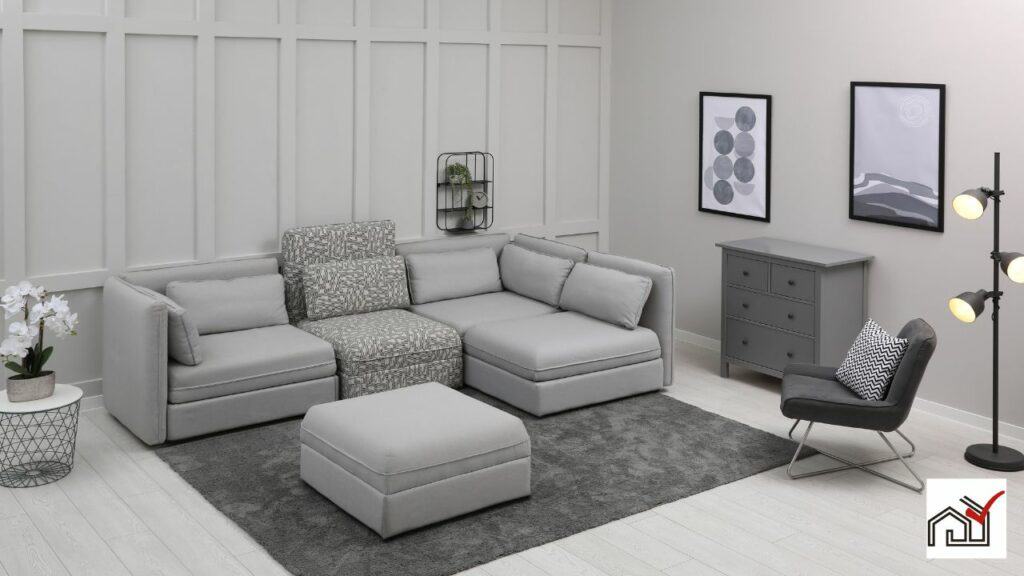Deciding if a sectional sofa needs end tables depends on both function and design. End tables are useful for holding items and can contribute to the room's look. But, it's important to consider the room size and the sectional's style and size when adding end tables.
While not essential, end tables can enhance a sectional sofa if they fit the user's needs and preferences.
Assessing Functional Needs
Assess the need for end tables by looking at how the space around the sectional sofa is used. A sectional sofa is a large piece of furniture that often sets the layout of a living room. It's important to consider how it will be used to ensure it is both comfortable and functional.
End tables are practical, providing a place to set drinks, books, or lamps within easy reach. They offer convenience for guests and can store items like remote controls and magazines, adding a personal touch to the room.
While a sectional provides plenty of seating, not having end tables may reduce practicality. End tables are key for keeping essential items close by, combining comfort with convenience. They are useful for various activities, such as eating snacks or reading with the aid of a lamp.
When deciding on end tables, consider other furniture pieces like coffee tables or storage ottomans that may serve similar purposes. The decision should balance the need for a tidy space with the functionality that supports the sectional's use in daily life.
Enhancing Aesthetic Appeal
End tables are not only practical but also enhance the look of a room, especially when paired with a sectional sofa. They play a crucial role in interior design by adding balance to the decor. These tables provide space for items like lamps and books, which contribute to the room's texture and color.
End tables can introduce new colors and materials to a room, preventing it from looking incomplete. Selecting tables that complement the sectional can help create a cohesive and welcoming space. These tables can also express personal style, adding a personal touch to the space.
Mixing different styles of end tables can make the living space more interesting. Varied styles and heights next to a sectional can add a unique visual element.
When chosen carefully, end tables enhance both the look and functionality of a room. They are essential in creating a well-designed interior.
Considering Space Constraints
When selecting furniture for a small room with a sectional sofa, consider the size of both the sofa and the room to decide if end tables are necessary. The aim is to balance function and design without overcrowding the space. Determine if the sectional's size eliminates the need for additional furniture or if end tables would make the space too cramped.
In small living spaces, choose furniture that doesn't take up too much room. A coffee table or built-in shelves can often replace end tables, providing a place to set drinks or display items without using as much space.
If end tables are needed for their practicality, pick ones that match the scale of the sectional and the room. Opt for designs that are slim and not bulky to save space. End tables with storage can be particularly useful, serving two purposes and helping to keep the space clutter-free.
Exploring Alternatives to Traditional End Tables
C-tables and multifunctional ottomans are practical alternatives to traditional end tables, especially useful in small spaces. C-tables fit over the arm of a sectional, providing a stable surface without taking up extra space. Tables with drawers are recommended for additional storage and can keep living rooms tidy.
Multifunctional furniture like ottomans can serve as footrests, seats, or coffee tables with a tray on top, and often include storage compartments. These options allow homeowners to maximize space and functionality while maintaining style in their living areas.
Selecting the Appropriate Size
When choosing end tables for a sectional sofa, it's important to match the size of the tables to the scale of the sofa to maintain balance and functionality. The end tables should be within reach from the seating area, not disrupt traffic flow, and should not be taller than the arm of the sectional.
They should fit within the sectional's footprint to maintain a cohesive look and be the right size to hold items while keeping the room's proportions.
Coordinating With Sectional Style
Selecting end tables that match the style of your sectional is important for a cohesive room design. Choose end tables that both serve their purpose and complement the sectional.
For a modern look, pair a leather sectional with simple metal end tables. For a cozy atmosphere, combine a fabric sectional with wooden end tables.
Consider the end tables' size and function relative to the sectional, especially in high-traffic areas or larger spaces that require additional storage. Properly coordinated end tables enhance both the room's aesthetics and its functionality.




